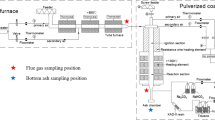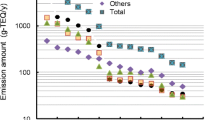Abstract
A simple, low-cost method for suppression of dioxins/furans (hereinafter referred to as dioxins) is required because many middle- and, especially, small-scale incinerators have fallen into disuse or have been dismantled because of the high running and system costs of measures for the suppression of dioxins. Therefore, the purpose of the present study was to develop a simple removal method for dioxins from combustion gas and to evaluate the basic removal rate of dioxins. The removal method for suspended matter in a gas mixture (cold model) and dioxins in exhaust gases (hot model) has been investigated by means of gas injection into water, the mechanism of which is that the suspended matter in the gas gathers at the gas–liquid interface. In the cold model, the removal ratio of fine particles (RP) by gas injection into water was reproduced well by the following equation: RP (%) = 100 × {1−exp(−0.8 · SS · tC)}, where SS (cm2/cm3) is the specific surface area of bubbles and tC (s) is the residence time of bubbles in water. The removal ratio of fine particles increased as the product Ss · tC increased. In a hot model using the exhaust gas from combustion experiments of polyvinyl chloride, the removal ratio of dioxins (RD) by injecting the exhaust gas into water was estimated by the following equation: RD (%) = 100 × {1−exp(−0.8 · SS · tC · CD0 0.07)}, where CD0 [ng/cm3 (at standard temperature and pressure)] is the dioxins concentration in the exhaust gas before injection into water. RD depends greatly on the specific surface area of bubbles and the residence time of the bubbles in water, and only weakly on the dioxins concentration in the exhaust gas. Injection of the exhaust gas into water has been shown to be effective and was evaluated as a simple method for the removal of dioxins from exhaust gas.
Similar content being viewed by others
References
H Vogg M Metzger L Stieglitz (1987) ArticleTitleRecent findings on the formation and decomposition of PCDD/PCDF in municipal solid waste incineration Waste Manag Res 5 285–294 Occurrence Handle10.1016/0734-242X(87)90080-2 Occurrence Handle1:CAS:528:DyaL2sXmt1altr0%3D
M Tanaka Y Masuda K Yasuda K Takahashi H Teshima I Kawakami H Miyata S Asada Y Oda (1997) Technology of prevention against dioxins formation on waste treatment NTS Tokyo, Japan
M Hiraoka (1998) ArticleTitlePresent and future of reduction plans for dioxins Sci Ind 72 IssueID8 319–332
Japanese Ministry of the Environment (2005) Inventory of dioxins emissions. November, Press release
H Kawabata T Usui K Marukawa S Hara T Tanaka H Ono-Nakazato (2003) ArticleTitleMechanism of dioxins/furans formation at high temperature in combustion processes ISIJ Int 43 IssueID3 461–467 Occurrence Handle1:CAS:528:DC%2BD3sXitlKrur4%3D
D Wang M Piao S Chu X Xu (2001) ArticleTitleChlorinated polycyclic aromatic hydrocarbons from polyvinylchloride combustion Environ Contam Toxicol 66 326–333 Occurrence Handle1:STN:280:DC%2BD3M3lvVSrsg%3D%3D
Marukawa K, Hara S, Kawabata H, Ono-Nakazato H, Usui T, Tanaka T (2003) Dioxins and recycling of resources. I: Fundamental studies on recovery of resources and energy in consideration of dioxins formation. Proceedings of International Symposium on Global Environment and Steel Industry (ISES'03, Beijing, China). 38:104–107
H Kawabata T Usui K Marukawa S Hara H Ono-Nakazato T Tanaka (2002) ArticleTitleEffects of chlorine sources and forms on formation of dioxins/furans in combustion processes J Jpn Soc Waste Manag Experts 13 IssueID4 184–192 Occurrence Handle1:CAS:528:DC%2BD3sXitVGqsbg%3D
P Wei K Uemura S Koyama (1992) ArticleTitleCold model experiment on entrapment of inclusions in steel by inert gas Tetsu-to-Hagane 76 IssueID8 1361–1368
H Kawabata T Usui (2005) ArticleTitleDioxin's removal from waste water by adsorbing on PE particles Proc Ann Conf JSWME 16 IssueIDE-4 1262–1264
BF Rordorf (1986) ArticleTitleThermal properties of dioxins, furans and related compounds Chemosphere 15 IssueID9–12 1325–1332 Occurrence Handle10.1016/0045-6535(86)90407-8 Occurrence Handle1:CAS:528:DyaL2sXksFynsrs%3D
WY Shiu W Doucette FAPC Gobas A Andren D Mackay (1988) ArticleTitlePhysical–chemical properties of chlorinated dibenzo-p-dioxins Environ Sci Technol 22 651–658 Occurrence Handle10.1021/es00171a006 Occurrence Handle1:CAS:528:DyaL1cXitV2gsrw%3D
Author information
Authors and Affiliations
Corresponding author
Rights and permissions
About this article
Cite this article
Kawabata, H., Yabunaka, B., Tanabe, M. et al. Simple removal of dioxins by injecting combustion gas into water. J Mater Cycles Waste Manag 9, 80–89 (2007). https://doi.org/10.1007/s10163-006-0162-9
Received:
Accepted:
Published:
Issue Date:
DOI: https://doi.org/10.1007/s10163-006-0162-9




